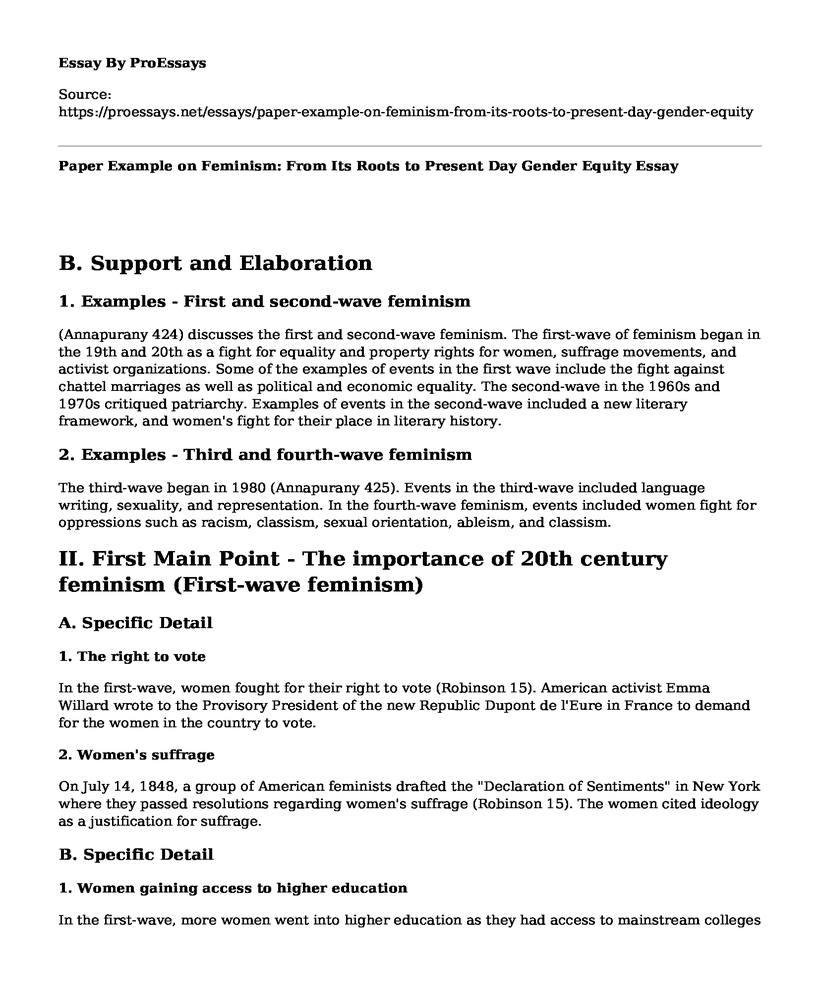B. Support and Elaboration
1. Examples - First and second-wave feminism
(Annapurany 424) discusses the first and second-wave feminism. The first-wave of feminism began in the 19th and 20th as a fight for equality and property rights for women, suffrage movements, and activist organizations. Some of the examples of events in the first wave include the fight against chattel marriages as well as political and economic equality. The second-wave in the 1960s and 1970s critiqued patriarchy. Examples of events in the second-wave included a new literary framework, and women's fight for their place in literary history.
2. Examples - Third and fourth-wave feminism
The third-wave began in 1980 (Annapurany 425). Events in the third-wave included language writing, sexuality, and representation. In the fourth-wave feminism, events included women fight for oppressions such as racism, classism, sexual orientation, ableism, and classism.
II. First Main Point - The importance of 20th century feminism (First-wave feminism)
A. Specific Detail
1. The right to vote
In the first-wave, women fought for their right to vote (Robinson 15). American activist Emma Willard wrote to the Provisory President of the new Republic Dupont de l'Eure in France to demand for the women in the country to vote.
2. Women's suffrage
On July 14, 1848, a group of American feminists drafted the "Declaration of Sentiments" in New York where they passed resolutions regarding women's suffrage (Robinson 15). The women cited ideology as a justification for suffrage.
B. Specific Detail
1. Women gaining access to higher education
In the first-wave, more women went into higher education as they had access to mainstream colleges and Universities.
2. White feminism: The black women who weren't published but made huge contributions to first-wave
Annapurany (424) stated that the first-wave had feminist literary analysis. The first literary analysis was William Shakespeare's assessment of Taming of the Shrew for Petruchio's abuse of Katherina.
III. Second Main Point - Second-wave feminism
A. Specific Detail
1. Birth control
Women fought for their liberation. The Food and Drug Administration (FDA) approved the birth control pill, which enable women to be in charge of their bodies when it comes to pregnancy (Second-wave Feminism 1).
2. The start of radical feminism
Radical feminism began because of unrest in the 1960s (Robinson 19). The second-wave began because of issues regarding class, race, socio-economic status, and the lack of recognition.
B. Specific Detail
1. Civil rights movement
The 1960s in the era of the civil rights movements, women across all walks of lives fought for their rightful place in American society (Second-wave Feminism 1). Members of the group National Organization for Women (NOW) fought for their rights and equality for themselves and others.
2. Domestic violence and sexual harassment
Second-wave feminists fought for the issue of physical violence and sexual assault at home and the workplace (James 646). Also, many women in post-war America faced domestic violence because men saw them as objects. Additionally, activists in the local law enforcement agencies created up to 48 shelters for battered women.
IV. Third Main Point - The importance of feminism today (Third and fourth-wave)
A.Specific Detail - Third-wave
1.Reclaiming derogatory terms
In part of 1980, radical feminists articulated queer politics to regain derogatory terms that were used to describe gay men and lesbians (Davis 1). The feminists distanced themselves from lesbian and gay movements because they felt that it reflected white gay, lesbians, and middle-class.
2.Sexual liberation
The third-wave experienced sexual liberation movements that marginalized individuals in the already existing groups (Davis 1). More sexual cultures and communities emerged to support transgender, gender non-conforming people, and people of color.
B. Specific Detail - Fourth-wave
1. White feminism - How minority women are disenfranchised
Gender equality has become a major problem, and feminists fight against oppression, vulnerability, lack of power, and freedom of women (Ruth and Vivienne 14). Feminists in the fourth-wave have a broader agenda of pushing for policies that help disenfranchised women.
2. Abortion and #MeToo
#MeToo emerged in October 2017 to fight against sexual harassment and sexual assault against women (Andersen 1). Fourth-wave explains #MeToo movement and the right for women to have an abortion if the wish. Feminists push for the movement on social media and other platforms to curb sexual harassment and rape.
Works Cited
Andersen, Mille. 'Getting to the Root of #metoo-Through the Fourth-wave of Feminism.' 2018. doi: 10.13140/RG.2.2.20534.14403.
Annapurany, K. "A prospective study of feminism waves, phases, issues and critical analysis." International Journal of Applied Research, vol. 2, no. 5, 2016, pp. 424-426. www.allresearchjournal.com/archives/2016/vol2issue5/PartG/2-4-146-845.pdf
Davis, Angela. "Third-wave and Queer Feminist Movements." 2017. https://courses.lumenlearning.com/suny-introwgss/chapter/third-wave-and-queer-feminist-movements/
Offen, Karen. "On the French origin of the words feminism and feminist." Gender Issues, vol. 8, 1998, Pp. 45-51. doi: 10.1007/BF02685596.
Patterson, James T. Grand Expectations: The United States, 1945-1974. New York: Oxford University Press. 1996. Press Phillips, Ruth, and Cree, Vivienne. "What does the 'Fourth-wave' mean for teaching feminism in 21st century social work?" Social Work Education, vol. 33, no. 7, 2018, pp. 930-943. doi: 10.1080/02615479.2014.885007
Rampton, Mary. "Four waves of feminism." 2015, www.pacificu.edu/magazine/four-waves Feminism
Robinson, Page S. "I'm Not a Feminist, But... A Comparative Analysis of the Women's Movement in the United States and France." Institut francais des relations internationals. 2010, https://www.ifri.org/sites/default/files/atoms/files/womensmovementsusafrance_pp4_somerville.pdf
Second-wave Feminism. 'Overview." Khan Academy. N.d, www.khanacademy.org/humanities/us-history/postwarera/1960s-america/a/second-wave-feminism
Cite this page
Paper Example on Feminism: From Its Roots to Present Day Gender Equity. (2023, May 30). Retrieved from https://proessays.net/essays/paper-example-on-feminism-from-its-roots-to-present-day-gender-equity
If you are the original author of this essay and no longer wish to have it published on the ProEssays website, please click below to request its removal:
- Essay Sample on Elder Abuse
- Are African-Americans the Target for Racial Prejudice or They Have Always Been Free?
- Social Media Enhances the Public Sphere Essay
- Essay Sample on Japanese Women Working
- Essay Example on Glass Ceiling: Invisible Barrier for Women, Minorities in Trade Hierarchy
- Essay Sample on Bullying in the Workplace: Recognizing the Subtle Signs
- Improving Public Health Through Community Food Projects - Essay Sample







